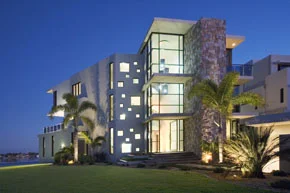Home Automation
Home Automation is a term used too often these days to describe almost any form of technology some what smarter or even just different to conventional home lighting and electrical. But home automation in its true form is alot more than a C-Bus or other home control system installed to switch on and off lights. The true purpose of a home automation system is to enrich and simplify the lives in our homes.
So what is true Home Automation?
Connected Living understands it is pointless to install a home automation product in your home if it is not providing benefits more than that of conventional lighting or electrical circuits. To automate the home, the electrical supply and control interfaces of the home systems are wired back to central control units. This then allows us to easily control and automate the systems in our home. Sensors, control interfaces such as touch screens, and time clocks are also connected to our home systems to monitor, receive and schedule the requirements of the home's occupants.
When we automate a home we can expect the benefits of some of the following features:
- Occupancy needs: Sensors throughout the home provide the automation system with information on occupant's movements. This allows us to program home automation systems to provide appropriate lighting, climate conditions, security, music or other entertainment requirements as they move throughout the home.
- Energy saving: Sensors and time clocks can detect occupancy movement, natural light levels, and time of day. With this information, we can provide artificial lighting only when required - saving energy and lowering electrical bills. Sensors can turn off lighting in areas where there is already sufficient natural lighting or when it is detected that an area is no longer occupied.
- Single button control: Control panels or touch panels can be programmed with features that allow us to do multiple things with one button. For example, an away button at our front door can turn off all the lighting in our home and turn on the security system, or a goodnight button next to our bed can turn off all lighting and systems in our home so you can be assured there is nothing left on to waste energy. Single buttons can also set moods by turnng on and dimming lighting appropriately, or switching on our favourite music.
- Climate control: The climate needs of the occupant can be stored and provided to the occupant in the most efficient manner possible. Natural elements that assist in the undesired climate conditions can be automatically shut out before the use of artificial cooling or heating. For example, when a home is too hot, certain blinds or shutters can be closed automatically, and windows can be opened for ventilation.
- Irrigation: Irrigation systems can be interfaced to the home's central controllers so your garden is always watered. Moisture sensors are used to detect the level of moisture in gardens so irrigation systems are never turned on when gardens are already sufficiently watered.
- Security: With the use of home automation systems, we can provide better security to the occupants of a home. Emergency lighting can be activated during a fire alarm, the whole house can be lit when intrusion is detected, or alarm systems can alert us on our phones. Security cameras can also be viewable over the internet when we are away.
This is just a taste of what real home automation systems can do for you in your home. Be careful not to use any "home automation" installer. You will find although many are "certified", many do not have the programming ability or integration know-how to automate a home. Thats why you can rely on Connected Living to provide the complete package for you!

